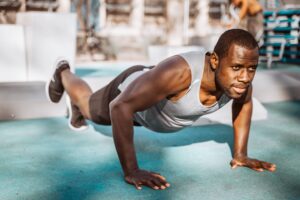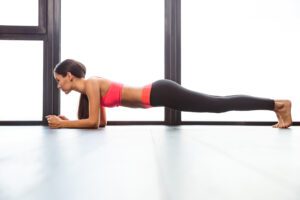Push-ups, a seemingly simple bodyweight exercise, have stood the test of time as a reliable measure of strength and endurance. Beyond their ubiquity in fitness routines, push-ups offer a myriad of benefits and engage a complex network of muscles. In this comprehensive exploration, we delve into the science behind push-ups, examining the muscles involved, the biomechanics of the exercise, and the wide-ranging benefits it brings to the body.
Muscles Engaged During Push-Ups
1. Pectoralis Major
The primary muscle engaged in push-ups is the pectoralis major, commonly known as the chest muscle. This muscle is responsible for the horizontal adduction of the arms, bringing them towards the midline of the body.
2. Deltoids
The deltoids, or shoulder muscles, play a crucial role in the abduction of the arms during push-ups. They assist in lifting the body up and lowering it down while stabilising the shoulder joint.
3. Triceps Brachii
Located on the back of the upper arm, the triceps brachii is responsible for extending the elbow joint. It is heavily engaged during the pushing phase of the push-up, aiding in the straightening of the arms.
4. Serratus Anterior
The serratus anterior, situated on the sides of the chest, is involved in the protraction and stabilization of the shoulder blades. It assists in maintaining proper shoulder mechanics during push-ups.
5. Rectus Abdominis
The rectus abdominis, commonly known as the abdominal or “six-pack” muscles, is engaged to stabilise the core and maintain a straight body position during the push-up.
6. Obliques
The obliques, located on the sides of the abdomen, assist the rectus abdominis in stabilising the core and preventing rotation of the torso.
7. Transverse Abdominis
Deeper than the rectus abdominis, the transverse abdominis functions as a stabiliser for the spine, providing support to the core during the entire push-up movement.
8. Quadriceps
The quadriceps, a group of muscles on the front of the thigh, engage to keep the legs straight and contribute to stabilising the lower body during the push-up.
9. Gluteus Maximus
The gluteus maximus, the largest muscle in the buttocks, is involved in maintaining hip extension and preventing the hips from sagging during the exercise.
10. Soleus and Gastrocnemius
The muscles of the calf, including the soleus and gastrocnemius, stabilise the ankles and contribute to maintaining a straight line from head to heels.
Biomechanics of the Push-Up
Understanding the biomechanics of push-ups is essential for performing the exercise effectively and maximising its benefits. The push-up can be broken down into two main phases: the lowering (eccentric) phase and the lifting (concentric) phase.
Eccentric Phase:
- Muscle Lengthening: As you lower your body towards the ground, the muscles involved undergo lengthening. This phase primarily involves the eccentric contraction of the chest, shoulders, and triceps.
- Energy Absorption: The muscles act as shock absorbers, absorbing the energy generated by the downward movement. This controlled descent is crucial for preventing injuries and maximising muscle engagement.
Concentric Phase:
- Muscle Shortening: The lifting phase involves the concentric contraction of the chest, shoulders, and triceps. The muscles shorten to push the body away from the ground.
- Force Generation: The muscles generate force to overcome gravity and lift the body back to the starting position.
- Stabilisation: Throughout both phases, the core muscles, including the rectus abdominis, obliques, and transverse abdominis, play a key role in stabilising the body and maintaining proper form.
Benefits of Push-Ups
1. Strength Building
Push-ups are a compound exercise that targets multiple muscle groups simultaneously. Regular practice leads to increased upper body and core strength, making it an effective bodyweight strength-building exercise.
2. Muscle Endurance
As a bodyweight exercise, push-ups require endurance, especially as the number of repetitions increases. Endurance is essential for sustaining physical activity over extended periods, contributing to overall fitness.
3. Improved Posture
Push-ups engage the muscles responsible for maintaining proper posture, including the chest, shoulders, and core. Consistent practice can contribute to better posture and alignment.
4. Functional Fitness
The functional nature of push-ups makes them valuable for everyday activities that require upper body strength and stability. This includes tasks like lifting and carrying objects, pushing doors open, and other daily movements.
5. Joint Stability
Push-ups engage the shoulder, elbow, and wrist joints, promoting joint stability. This can be particularly beneficial for individuals looking to improve joint health and reduce the risk of injuries.
6. Versatility
Push-ups offer versatility in terms of variations and progressions. From standard push-ups to advanced variations like one-arm or handstand push-ups, individuals can tailor their workouts to their fitness levels and goals.
7. Time Efficiency
Push-ups are a time-efficient exercise that can be done virtually anywhere, requiring no special equipment. This makes them an accessible and convenient option for individuals with busy schedules.
8. Cardiovascular Benefits
Performing push-ups at a moderate to high intensity can elevate the heart rate, contributing to cardiovascular fitness. Incorporating push-ups into a high-intensity interval training (HIIT) routine can enhance cardiovascular health.
9. Adaptability for All Fitness Levels
Push-ups can be adapted to accommodate various fitness levels. Beginners can start with incline push-ups, while advanced individuals can challenge themselves with more complex variations, ensuring inclusivity in fitness programmes.
Common Push-Up Variations
- Standard Push-Up: The classic push-up, performed with hands beneath the shoulders and body in a straight line.
- Wide-Grip Push-Up: Hands placed wider than shoulder-width to target the outer chest.
- Close-Grip Push-Up: Hands positioned closer together to emphasise triceps engagement.
- Incline Push-Up: Performing push-ups with hands elevated on a surface, reducing the load on the upper body.
- Decline Push-Up: Feet elevated on a surface, increasing the difficulty and engaging the upper chest.
- Diamond Push-Up: Hands form a diamond shape beneath the chest, targeting the triceps and inner chest.
- One-Arm Push-Up: A challenging variation that requires significant upper body strength and stability.
Conclusion
The science behind push-ups reveals a multifaceted exercise that engages numerous muscles and offers a plethora of benefits. From building strength and endurance to improving posture and cardiovascular health, push-ups are a versatile and accessible addition to any fitness routine. Understanding the biomechanics and muscles involved allows individuals to perform push-ups with proper form, maximising their effectiveness and reducing the risk of injury. Whether you’re a beginner or a fitness enthusiast, incorporating push-ups into your regular routine can contribute to overall health, functional fitness, and a stronger, more resilient body.



